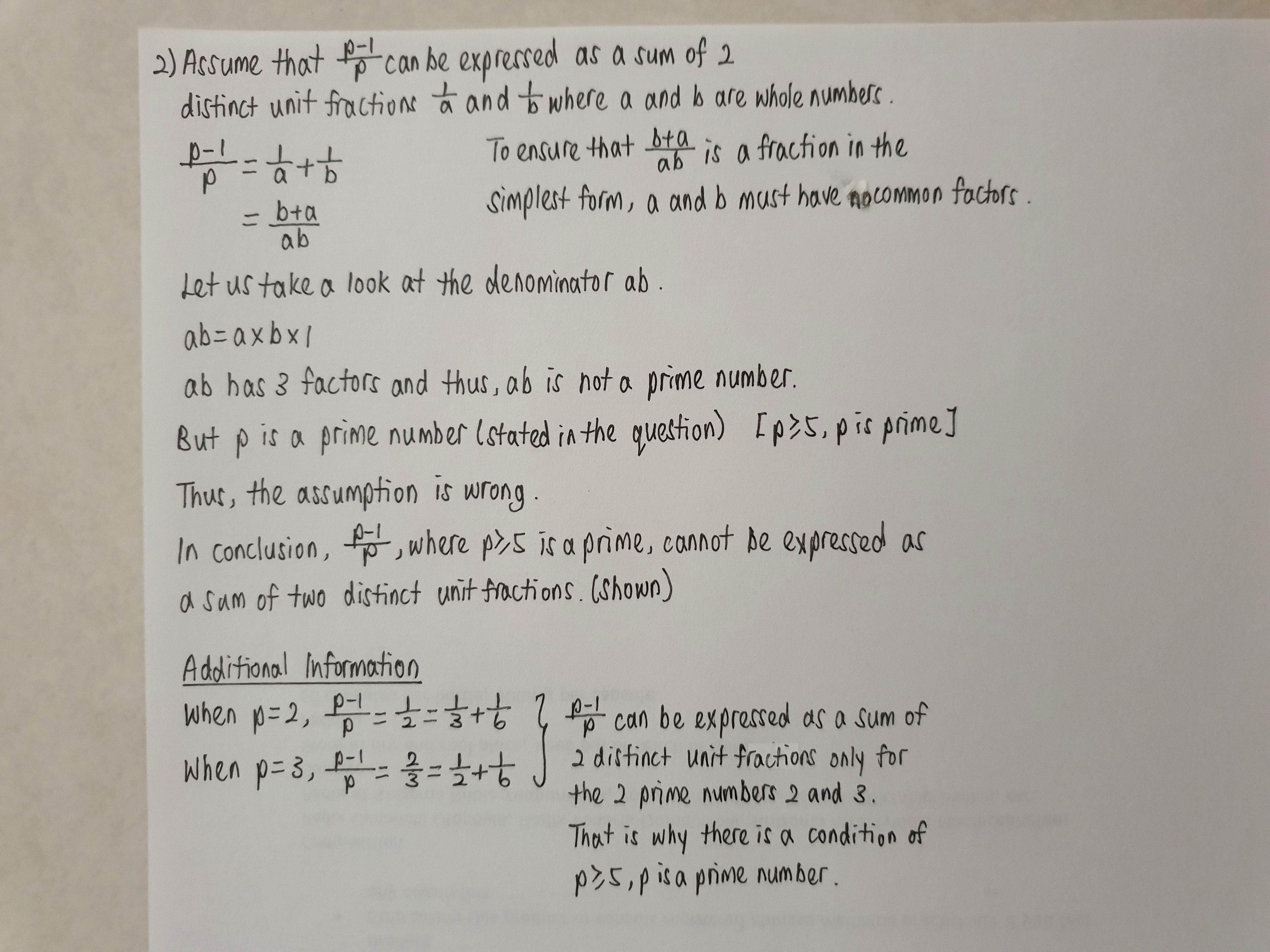Ask Singapore Homework?
Upload a photo of a Singapore homework and someone will email you the solution for free.

Question
secondary 2 | Maths
One Answer Below
Anyone can contribute an answer, even non-tutors.

hello everyone! could anyone please help me to solve this problem? thank you so much! :)
The product ab rises at a very fast rate, much faster than a + b, when a and b are 3 or more.
1/a + 1/b = (a + b)/ab
For example, 1/3 + 1/4 = 7/12
The denominator rises much more quickly than the numerator, but in the case (p - 1)/p, the numerator must be exactly 1 less than the denominator.
You cannot achieve this difference at higher values of a and b. Moreover, (p - 1)/p is already a fraction in its simplest form (other than 2 and 3, a prime number differs from the previous prime number by more than 1).
This explains why the statement in the question is as such.
See 1 Answer
For distinct unit fractions, the denominators must be different. So we can let two distinct unit fractions be represented by 1/m and 1/n, where m ≠ n m > n and both m and n are positive integers.
If it can be expressed as a sum of two distinct fractions, then 1/m + 1/n = (p-1)/p
Note that (p - 1)/p always < 1 for all positive integer values of p as numerator is smaller than denominator.
So m and n cannot be 1 as that would make (1/m + 1/n) bigger than 1.
The largest possible sum of two distinct unit fractions is ½ + ⅓, since they are the two largest unit fractions.
½ + ⅓ = 5/6, which satisfies the condition
(p - 1)/p. So it is possible to express when p = 6.
Notice that when p ≥ 7, (p-1)/p > 5/6.
eg. 6/7, 7/8, 8/9, 9/10, 10/11 and so on.
Since ½ + ⅓ is already the largest possible sum of two distinct unit fractions,
For p ≥ 7, (p-1)/p cannot be expressed as a sum of two distinct unit fractions, since it will be larger than ½ + ⅓. There aren't any two unit fractions larger than these whose sum equals (p-1)/p for p≥ 7.
For p = 5, (p - 1)/p = 4/5
Assume 4/5 = 1/m + 1/n
Since m > n, 1/m < 1/n,
then 1/m + 1/n < 2/n
So 4/5 < 2/n
4n < 10
n < 2.5
Since n ≠ 1 and n is a positive integer,
n = 2
Thus 4/5 = 1/m + 1/2
1/m = 3/10
m = 10/3
But m has to be a positive integer. So m cannot be 10/3. This means that when p = 5, it is also not possible to express as a sum of two distinct unit fractions.
From the above , we can conclude that it is not possible for p ≥ 5, p ≠ 6. This includes the prime numbers that are ≥ 5.
3/4 = 1/4 + 2/4 = 1/4 + 1/2
2/3 = 8/12 = 2/12 + 6/12 = 1/2 + 1/6
1/2 = 3/6 = 1/6 + 2/6 = 1/6 + 1/3
1/m + 1/n = (m+n)/mn.
Note that (m+n)/mn need not necessarily be in the simplest form.
For example, when m = 2 and n = 6,
1/6 + 1/2 = (6 + 2)/(6 x 2) = 8/12 = 2/3
note that mn = 8 in this case and thus mn does not necessarily have to be prime.





